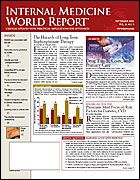Publication
Article
Internal Medicine World Report
Accredited Stroke Certification Enhances Patient Care
Author(s):
From the American Stroke AssociationImprovement in Performance Measures Confirmed
Kissimmee, Fla?Certification of a stroke center by the Joint Commission on Accreditation of Healthcare Organizations (JCAHO) leads to improvements in the care of stroke patients, said investigators at the American Stroke Association's International Stroke Conference 2006.
Performance measures, such as lipid profile screening, discharge on antithrombotic therapy, and prophylaxis for deep-vein thrombosis (DVT), were evaluated in a study of hospitals that went through the JCAHO certification process from February 2004 through June 2005, reported Mark J. Alberts, MD, professor of neurology and director of the stroke program at Northwestern University, Chicago.
Most of the 83 certified hospitals (77%) were nonacademic facilities, with an average bed size of 521 and an average of 403 stroke patients annually. A pilot study of 35 hospitals ascertained longitudinal changes over 6 months in 10 stroke-related performance measures.
Improvements were observed in 9 of these measures during the assessment period. The most dramatic were a 13.6% increase (69.6% vs 83.2%; P = .004) in compliance with smoking cessation guidelines and an 8.2% increase (78.4% vs 86.6%; P = .01) in DVT prophylaxis. Additional areas of improvement on discharge included the following increases:
? 7.6% in patient education (P?= .01)
? 6.5% in consideration of tissue plasminogen activator (t-PA) therapy (P?= .09)
? 5.9% in screening for dysphagia (P?= .07)
? 5.1% in obtaining lipid profiles (P?= .01)
? 4.1% in the proportion of patients discharged on antithrombotic therapy (P?= .02)
? 1.7% in the proportion of patients with atrial fibrillation (AF) who were discharged on anticoagulation (P?= .9)
? 1.6% in rehabilitation planning (P?= .01).
Dr Alberts notes that the use of antithrombotic agents within 48 hours and anticoagulation for AF were already high at baseline, leaving little room for improvement. "The most common deficiency was in documentation of patient education, which was cited in 11 hospitals," he said.
One California hospital that was certified as a primary stroke center had a significant increase in the percentage of patients receiving lipid profile testing, medication to prevent DVT, and thrombolytic therapy.
Dana Stradling, RN, of the University of California Irvine Medical Center, Orange, described trends in stroke delivery care at her institution for the 1.5 years following JCAHO stroke center certification as compared with the previous 2.5 years.
Data were obtained from a review of medical records and discharge summaries between July 1, 2001, and June 30, 2005, during which time 1161 patients were admitted for stroke.
Among patients with ischemic stroke, stroke certification was associated with a significant (P?<.001) increase in the proportion of patients receiving lipid profile testing (71% pre- vs 86% postcertification) and DVT prophylaxis (80% pre- vs 98% postcertification). "Furthermore, with establishment of an inpatient stroke service 6 months after certification, the fraction of patients undergoing lipid profile testing rose to 92%; for DVT prophylaxis, to 99%," she said.
The rate of IV t-PA use since stroke certification increased from 3 to 10 patients per year, as did the rate of either IV or intra-arterial thrombolysis (from 4 to 14 patients per year).
An increase in the stroke admission rate was also observed, which may have been influenced by certification status, but may also have been the result of changes in hospital policies, personnel, advertising, the hiring of a neurointensivist, and the erosion of regional neurosurgical on-call coverage, she said.






